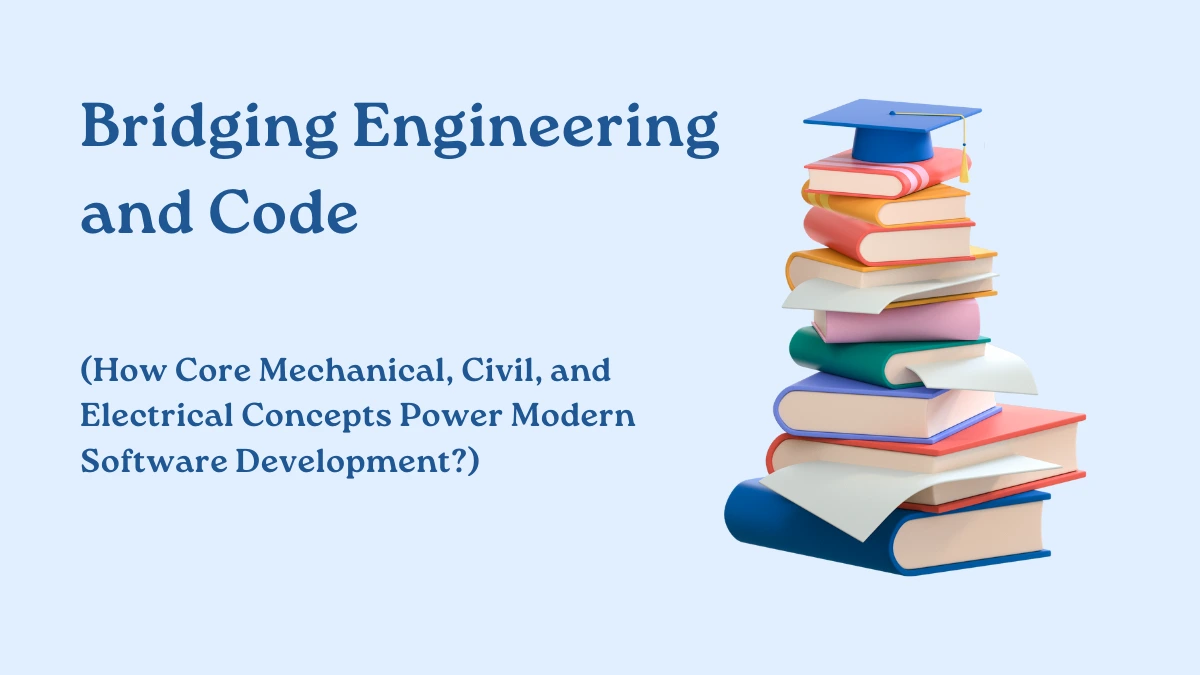Bridging Engineering and Code: How Core Mechanical, Civil, and Electrical Concepts Power Modern Software Development
In the 21st century, the distinction between engineering and software development is rapidly blurring. Mechanical, civil, and electrical engineers are no longer confined to physical systems — they’re now shaping the digital world through simulation software, automation tools, and AI-driven engineering solutions.
This blog explores how engineering concepts that power software development — from mechanics and structural analysis to circuit theory and thermodynamics — have evolved into essential pillars for modern coding, simulation design, and Industry 4.0 engineering.
From Blueprints to Algorithms: The Engineering Mindset in Coding
Software development is, at heart, an engineering process.
Engineers bring a structured system-thinking mindset that makes coding more intuitive and scalable.
Key overlaps
- System Thinking in Software Architecture: Engineers visualize entire systems — from bridges and motors to buildings — and apply that mindset to developing scalable software architectures.
- Mathematical Modelling in Coding: The same equations used to model stress, strain, flow, or voltage are now crucial for simulation tools, numerical algorithms, and engineering-driven software solutions.
- Optimization: Just as engineers optimize loads or power outputs, developers optimize algorithms, memory usage, and performance.
Core engineering logic makes an engineer’s transition to software development smoother — and often more innovative.

Mechanical Engineering Concepts in Software Development
Mechanical engineers shine in physics-heavy domains of development.
Real-world applications
- CAD/CAE & Simulation Software Development: Tools like ANSYS, SolidWorks, and MATLAB rely on mechanical principles. Engineers help build solvers using finite element analysis software, computational mechanics, and fluid dynamics.
- Robotics & Automation Coding: Kinematics, control systems, and dynamics are critical for robotics algorithms and automation pipelines.
- Digital Twins Engineering: Creating virtual replicas of machines or systems is a blend of mechanical insight, coding, and data modelling.
- Physics-Based Modelling in Software: Elasticity, thermodynamics, and motion equations form the foundation of simulation-driven design.
Languages often used:
Python for engineering simulations, C++ for performance, MATLAB for algorithm development.
Civil Engineering Concepts Transforming Software Solutions
Civil engineers now blend structural knowledge with coding expertise. Applications include:
- BIM Software Development (Revit/STAAD/Tekla): Implementing stiffness matrices, FEM solvers, and structural algorithms requires expertise in the civil domain.
- GIS & Smart Infrastructure Software: Surveying, mapping, and geospatial analysis merge with APIs and GIS software development using JavaScript/Python.
- Structural Analysis Software Algorithms: Engineers write solvers that calculate load distribution, stability, and material behavior.
- Construction Tech Automation: Project scheduling, cost estimation and resource optimization apply OR and engineering economics.
Read More: Civil Engineering Syllabus
Electrical Engineering Principles Driving the Digital Revolution
Software and electrical engineering are natural allies — both revolve around logic, control, and systems.. Applications include:
- Embedded Systems & IoT Development: Writing C/C++ firmware for sensors, circuits, and controllers.
- Control Systems & DSP Software: Algorithms for process control, robotics, and signal processing heavily depend on electrical principles.
- Smart Grids & Power System Simulation Software: Energy management platforms rely on electrical domain knowledge and data modelling.
- AI in Electronics Engineering: ML-based fault detection, predictive maintenance, and circuit optimization combine electrical engineering with coding.
Frameworks used:
Python, MATLAB/Simulink, C/C++.
The Rise of Interdisciplinary Engineers
The industry now demands interdisciplinary engineering skills — people who understand both physics and programming.
Key trends:
- Industry 4.0 & Digital Twins Engineering
- AI & Data-Driven Engineering
- Cloud-based Simulation Tools
- Simulation-Driven Design (SDD)
Future engineers must be fluent in both coding and core engineering principles.
Why Core Engineering Knowledge Makes Better Developers
Engineers with real-world domain skills bring unmatched value.
They can:
- Develop accurate simulation algorithms.
- Understand hardware and system constraints.
- Communicate with design teams.
- Build safer, more reliable systems.
- Innovate at the intersection of physical + digital engineering.
They form the backbone of aerospace tech, civil infrastructure systems, robotics, energy, automotive design, and smart infrastructure software.
Final Thoughts: Engineering the Future Through Code
As the world embraces automation, smart systems, and AI-led design, the demand for engineers who understand both engineering fundamentals and software development will continue to grow.
Whether you’re a mechanical engineer developing simulation tools, a civil engineer automating design workflows, or an electrical engineer writing embedded code — your engineering foundation is your superpower.
The bridge between engineering and software is no longer optional — it is the future.
Read More: How Clearing the GATE Can Open Doors to MS Programmes in Foreign Universities
Important GATE EE-EC Topics
FAQS
How do engineering concepts help in software development?
Engineering concepts enable developers to build accurate algorithms, simulation models, and reliable digital systems by applying systems thinking, mathematical modelling, and optimisation.
Can mechanical engineers transition into software development easily?
Yes. Mechanical engineers already possess a strong foundation in simulation, modelling, and problem-solving, making the transition into coding, automation, and simulation-driven design a smooth one.
What programming languages should engineers learn for engineering-focused software development?
Python for simulations, C++ for performance-heavy applications, MATLAB/Simulink for modelling, and JavaScript or C# for GIS/BIM integrations.
How does civil engineering knowledge help in coding?
Civil engineers excel in structural analysis, FEM, BIM, GIS, and infrastructure modelling — all fields requiring domain-specific software development skills.
How is electrical engineering used in software development?
Electrical engineering powers embedded systems programming, IoT development, digital signal processing (DSP), control system algorithms, and smart grid simulations.
What industries benefit the most from interdisciplinary engineers?
Industries such as aerospace, automotive, robotics, energy systems, construction tech, IoT, smart grids, and infrastructure modelling rely heavily on engineers who can code.
What is Industry 4.0, and how does it relate to software and engineering?
Industry 4.0 combines automation, AI, IoT, and digital twins to create smart industrial ecosystems where physics-based engineering meets software innovation.
Is coding necessary for modern engineers?
Absolutely. Coding is now essential for simulations, automation, data modelling, digital manufacturing, and engineering analytics.
What are the best software tools for engineers transitioning into tech?
ANSYS, MATLAB, SolidWorks, AutoCAD APIs, Revit plug-ins, Simulink, Python libraries (NumPy/SciPy), and C++ simulation frameworks.
How do digital twins revolutionize engineering workflows?
Digital twins combine mechanical modelling, civil infrastructure data, and electrical system intelligence to create real-time virtual replicas of physical systems.



